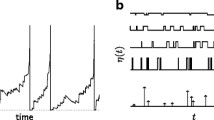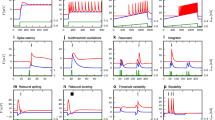Abstract
Methods of analysis for some deterministic and stochastic variants of the integrate-to-threshold neural coding scheme are presented. Adaptation phenomena are modeled by means of feedforward and feedback adaptive threshold control. Simulations of sinusoidal and step responses reproduce satisfactorily the qualitative characteristics of adaptation as compared with physiological data. It is postulated that such adaptive threshold control may be accomplished by the release, or conformation change, of molecules involved in the control of excitable-channel dynamics.
Similar content being viewed by others
References
Bartlett, M.S.: The spectral analysis of point processes. J. R. Statist. Soc. B. Vol. 25, 264–287 (1963)
Bayly, E.J.: Spectral analysis of pulse frequency modulation in the nervous system. IEEE Trans. Biomed. Eng. BME-15, 257–265 (1968)
Bullock, T.H.: Neuron doctrine and electrophysiology. Science 129, 997–1002 (1959)
Carlson, A.B.: Communication systems. Tokyo: McGraw Hill Kogakusha 1975
Chung, S.-H., Raymond, S.A., Lettvin, J.Y.: Multiple meaning in single visual units. Brain Behav. Evol. 3, 72–101 (1970)
Cole, K.S.: Ions and impulses — A chapter of classical biophysics. Berkeley: U.C. Berkeley Press 1968
Enroth-Cugell, C., Robson, J.G.: The contrast sensitivity of retinal ganglion cells of the cat. J. Physiol. 187, 517–552 (1966)
Fohlmeister, J.F.: A model for phasic and tonic repetitively firing neuronal encoders. Kybernetik 13, 104–112 (1973)
Fohlmeister, J.F., Poppele, R.E., Purple, R.L.: Repetitive firing: Dynamic behavior of sensory neurons reconciled with a quantitative model. J. Neurophysiol. 37, 1213–1227 (1974)
Fohlmeister, J.F., Poppele, R.E., Purple, R.L.: Repetitive firing: A quantitative study of feedback in model encoders. J. Gen. Physiol. 69, 815–848 (1977a)
Fohlmeister, J.F., Poppele, R.E., Purple, R.L.: Repetitive firing: Quantitative analysis of encoder behavior of slowly adapting stretch receptor of crayfish and eccentric cell of limulus. J. Gen. Physiol. 69, 849–877 (1977b)
Friedman, B.: Principles and techniques of applied mathematics. New York: Wiley & Sons 1956
Gerstein, G.L., Perkel, D.H.: Mutual temporal relationships among neuronal spike trains. Biophys. J. 12, 453–473 (1972)
Gestri, G.: Pulse frequency modulation in neural systems. Biophys. J. 11, 98–109 (1971)
Harmon, L.D., Lewis, E.R.: Neural modelling. Physiol. Rev. 46, 513–591 (1966)
Hodgkin, L.: The conduction of nervous impulse. Springfield, Ill.: Thomas 1964
IBM System/360 Continuous System Modelling Program-System Manual
Knox, C.K.: Signal transmission in random spike trains with applications to the statocyst neurons of the lobster. Kybernetik 7, 167–174 (1970)
Lee, H.C.: Integral pulse frequency modulation with technological and biological applications. Ph.D. dissertation, McGill Univ., Montreal, Quebec, 1969
Lee, H.C., Milsum, J.H.: Statistical analysis of multiunit, multipath neural communication. Math. Biosci. 11, 181–202 (1971)
Li, C.C.: Integral pulse frequency modulated control systems. Ph.D. dissertation, Northwestern University, Illinois, 1961
Milgram, P., Inbar, G.F.: Distortion suppression in neuronmuscular information transmission due to interchannel dispersion in muscle spindle firing thresholds. IEEE Trans. Biomed. Eng. BME-23, 1–15 (1976)
Papoulis, A.: Probability, Random variables, and stochastic processes. New York: McGraw Hill 1965
Papoulis, A.: The Fourier integral and its applications. New York: McGraw Hill 1962
Pavlidis, T.: Analysis and synthesis of pulse frequency modulation feedback systems. Ph.D. dissertation, University of California, Berkeley, 1964
Perkel, D.H., Bullock, T.M.: Neural coding. Neurosci. Res. Program Bull. 6, 221–348 (1968)
Perkel, D.H.: Spike trains as carriers of information. In: The neurosciences, second study program. Schmidt, F.O. (ed.), p. 587. New York: Rockefeller Univ. 1970
Poppele, R.E., Chen, W.J.: Repetitive behavior of mammalian muscle spindle. J. Neurophysiol. 35, 357–364 (1972)
Rowe, H.E.: Signals and noise in communication systems. New Jersey: Van Nostrand Comp. 1965
Sanderson, A.C., Calvert, T.W.: Distribution coding in neural interaction models. Internal Report, Carnegie-Mellon University, Pittsburgh, PA, 1973
Segundo, J.P.: Communication and coding by nerve cells. In: The neurosciences, second study program. Schmidt, F.O. (ed.), p. 569. New York: Rockefeller Univ. 1970
Siebert, W.M.: Frequency discrimination in the auditory system: Place of periodicity mechanism? Proc. IEEE 58, 723–730 (1970)
Snyder, D.L.: Random point processes. New York: Wiley & Sons 1975
Stein, R.B.: The role of spike trains in transmitting and distorting sensory signals. In: The neurosciences, second study program. Schmidt, F.O. (ed.), p. 597. New York: Rockefeller Univ. 1970
Stein, R.B., French, A.S., Holden, A.V.: The frequency response, coherence, and information capacity of two neuronal models. Biophys. J. 12, 295–322 (1972)
Stein, R.B., French, A.S.: Models for the transmission of information by nerve cells. In: Proc. Fifth International Meeting of Neurophysiologists, Oslo, 1970
Sugiyama, H., Moore, G.P., Perkel, D.H.: Solutions for a stochastic model of neuronal spike production. Math. Biosci. 8, 323–341 (1970)
Terzuolo, C.A.: Data transmission by spike trains. In: The neurosciences, second study program. Schmidt, F.O. (ed.), p. 661. New York: Rockefeller Univ. 1970
Verveen, A.A., De Felice, L.J.: Membrane noise. Prog. Biophys. Mol. Biol. 28, 189–265 (1974)
Verveen, A.A., Derksen, H.E.: Fluctuation phenomena in nerve membrane. Proc. IEEE 56, 906–915 (1968)
Walløe, L.: Transfer of signals through a second order sensory neuron. Inst. of Physiology, Univ. Oslo, 1968
Wright, M.J., Ikeda, H.: Processing of spatial and temporal information in the visual system. In: The neurosciences, third study program. Schmidt, F.O., Worden, F.G. (eds.). Cambridge, MA: MIT Press 1974
Zeevi, Y.Y., Bruckstein, A.M.: A note on single signed integral pulse frequency modulation. IEEE Trans. Syst. Man Cybern. SMC-7, 875–877 (1977)
Author information
Authors and Affiliations
Rights and permissions
About this article
Cite this article
Bruckstein, A.M., Zeevi, Y.Y. Analysis of “integrate-to-threshold” neural coding schemes. Biol. Cybernetics 34, 63–79 (1979). https://doi.org/10.1007/BF00365471
Received:
Issue Date:
DOI: https://doi.org/10.1007/BF00365471




